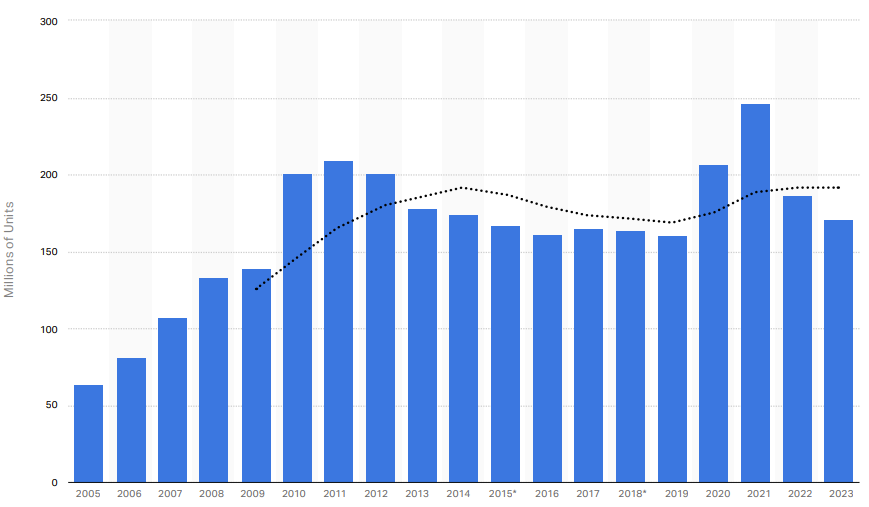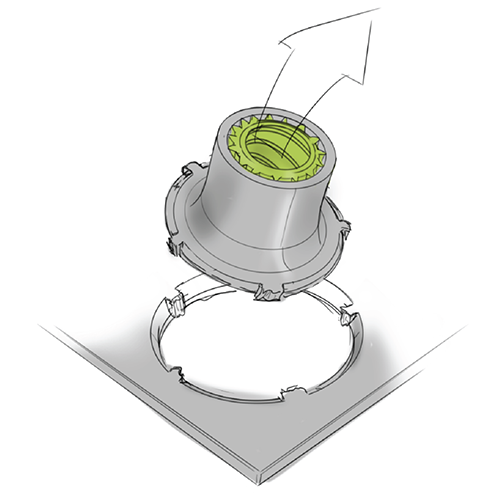Closed-loop Laptop Project Promotes Circularity

Dell and Covestro partner on boosting laptop recycling and limiting electronics waste
See also this story about Nashville group TERRA tackling e-waste
Tech giant Dell Technologies Inc. has been very vocal and transparent about closing the loop and driving increased circularity of its products. With annual sales of just over $102 billion, the Round Rock, Texas-based company has pledged to source more than half of its product content from recycled, renewable, or reduced carbon emissions material. It also intends to produce all of its packaging from recycled or renewable material by 2030.
There are many paths to circularity and improved environmental performance, not least of which involves closing the loop on the recycling of its laptop and notebook computers. To achieve that, they must make the products easier to disassemble and repair.

Global notebook computer unit volume, 2005-2023. Courtesy of Statista
Dell Focusing on Sustainable Materials

Ultrasonic welding these C and D parts together provides a structural, homogeneous part and eliminates inserts, screws, fasteners and adhesives.
They also are striving to use more eco-friendly materials, from bio-based and ocean-bound plastics to recycled metals and resins, as well as more closed-loop materials reclaimed from mountains of electronic waste. The firm says it has diverted more than 443,000 pounds of waste plastic bound for the ocean and repurposed it in its laptops. It also is using waste carbon fiber reclaimed from the aircraft industry. (See more on its website.)
Dell partnered with German advanced materials producer Covestro on a project focused on the closed-loop recycling of its laptops. Covestro, the world’s largest producer of polycarbonate (PC) resins and blends, acknowledges there is only a limited supply of transparent, high-purity PC and PC blends that can be ground-up after its first life and re-incorporated into new plastic materials. That makes finding ways to isolate, recover and recycle used PC back into the same application even more critical. That’s the very definition of closed-loop.
Studying How Regrind Resin Performs

Breakaway features such as these allow recyclers to recover the majority of the laptop’s polycarbonate resin.
Its partnership with Dell Technologies set out to determine whether engineering properties such as tensile strength, impact resistance and flame retardance could be retained when plastic components (both painted and unpainted) from previously used laptops were recovered, ground-up and reincorporated into plastic used for molding new laptop parts.
Covestro said the study used its Bayblend PC/ABS plastic, which has a mineral filler, is flame-retarded (FR) and contains 30 percent post-consumer recyclate (PCR). After grinding up the molded parts they added 20 percent more regrind to the compound in each loop.
This increased the recycled content in the plastic after each loop, starting with 30 percent recycled content. They then increased that to 44 percent recycled content after first loop, to 58 percent after the second loop, and to 72 percent after the third loop.
Covestro said it discovered that when it used a well-defined source to generate the regrind, the new resin’s engineering properties did not deteriorate markedly. They were, in fact, similar to the original plastic used, even after three recycling loops.
“Since the average lifetime of a laptop is three to eight years, going through three of these closed loops would keep plastic laptop components in circulation for up to 32 years,” it noted.
Applying Circular Design Principles Aids the Cause

Designing threaded inserts with this “breakaway” feature allows for homogenous disassembly.
The partners also recognized they could achieve further gains by employing circular design principles –– such as design for disassembly –– from the beginning of the product’s life cycle. This involved finding ways to reduce the number of metal-threaded inserts wherever possible, while also using fewer glues and adhesives. Wherever possible they found that using plastic-to-plastic joining methods, such as heat staking, instead of metal components also was beneficial.
One could use ultrasonic welding on certain notebook or laptop computer covers to eliminate inserts and screws, or produce a molded-in wire harness to eliminate tape. Some threaded inserts could be designed with a “breakaway” feature to help aid homogenous disassembly.
Additionally, the companies explored the complex redesign of such components as displays, electronic boards and EMI shielding. Doing so helps to enable the creation of a laptop that is easier to repair, upgrade and recycle.
Boosting Recoverable PC/ABS Resin

Using a molded-in wire harness such as this eliminates the need to use tape to hold it in place.
Citing market research from Statista that estimated 2023 global notebook volume at about 175 million units, they game-planned how much usable PC/ABS resin could be recovered using different scenarios ranging for product redesign to improvements in reverse supply chain infrastructure.
With some redesign, Covestro estimates that up to 400 grams of plastic can be recovered per notebook, compared to roughly 50 grams that are recoverable from today’s traditional designs. (Dell separately offers a brief video about sustainable laptop design.)
“Commercial and education laptops appear to be the ideal first category to look at,” noted Covestro. “Scale and material uniformity are worthwhile, and the ability to recapture fleet notebooks at trade-in time is higher. These notebooks have better known use histories and environmental aging conditions, so the tolerances on PCR quality should be tighter.”
The future, the company suggests, is closed-loop. “The next steps are for OEMs to utilize more efficient designs and for recyclers to achieve higher ‘Take Back’ rates. Working together, Covestro, recyclers and OEMs can create an ecosystem that significantly reduces the amount of e-waste.”
